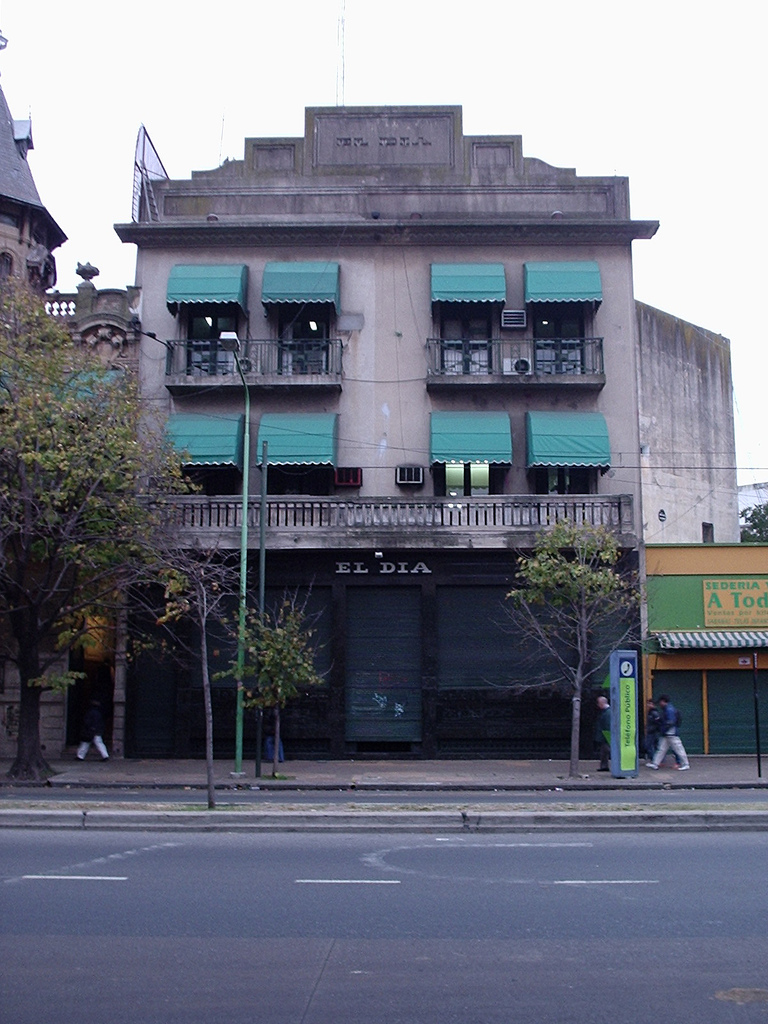El Día (La Plata) on:
[Wikipedia]
[Google]
[Amazon]
 ''El Día'' is an Argentine
''El Día'' is an Argentine
Lazos de la red mayor
{{DEFAULTSORT:Dia Daily newspapers published in Argentina Spanish-language newspapers Newspapers established in 1884 Mass media in La Plata
 ''El Día'' is an Argentine
''El Día'' is an Argentine daily newspaper
A newspaper is a periodical publication containing written information about current events and is often typed in black ink with a white or gray background.
Newspapers can cover a wide variety of fields such as politics, business, spor ...
published in the city of La Plata
La Plata () is the capital city of Buenos Aires Province, Argentina. According to the , it has a population of 654,324 and its metropolitan area, the Greater La Plata, has 787,294 inhabitants. It is located 9 kilometers (6 miles) inland from th ...
.
History
A year following the establishment of the city ofLa Plata
La Plata () is the capital city of Buenos Aires Province, Argentina. According to the , it has a population of 654,324 and its metropolitan area, the Greater La Plata, has 787,294 inhabitants. It is located 9 kilometers (6 miles) inland from th ...
as the capital of the Province of Buenos Aires, four local intellectuals, Manuel Lainez, Arturo Ugalde, Martín Biedma and Julio Botet formed a partnership with the purpose of giving the new town (the first planned city in Argentina and South America) a daily newspaper. The hamlet depended on Buenos Aires
Buenos Aires ( or ; ), officially the Autonomous City of Buenos Aires ( es, link=no, Ciudad Autónoma de Buenos Aires), is the capital and primate city of Argentina. The city is located on the western shore of the Río de la Plata, on South ...
media and counted with only one local periodical: ''La Propaganda'' (a listing of classified ads). Their preparation led to the 2 March 1884, launch of ''El Día'', whose first issue boasted 4 pages and cost 5 cents; 900 copies were circulated that day.
Published in a small building near the former freight railway depot
The motive power depot (MPD) or locomotive depot, or traction maintenance depot (TMD), is the place where locomotives are usually housed, repaired and maintained when not being used. They were originally known as "running sheds", "engine shed ...
, the owners of the struggling daily persuaded a distinguished retired journalist, José María Mendía, to serve as its first director.
Soon earning renown for its timely coverage and for its outspoken editorials section on page 4, ''El Día'' was directed for most of the era between 1894 and 1952 by Hugo Stunz, who fended off periodic competition from the numerous upstart dailies which enjoyed a passing history in La Plata during the 20th century. The growing daily drew much of its new staff from the prestigious local University of La Plata
The La Plata National University ( es, Universidad Nacional de La Plata, UNLP) is one of the most important Argentine national universities and the biggest one situated in the city of La Plata, capital of Buenos Aires Province. It has over 90 ...
and its related high-school, the Colegio Nacional. From the latter, ''El Dia'' hired David Kraiselburd, who would become a prominent local lawyer, head of the university alumni federation, and journalist.
By 1961, Kraiselburd had become editor-in-chief, and, along with the Fascetto family (heirs of Stunz's daughter), bought an important share of ''El Dia''. Inheriting a financially strapped company, Kraiselburd's staunch opposition to the era's military coups, and innovations such as special sections, helped recover ''El Día'', whose circulation soon averaged over 70,000.
Kraiselburd was murdered by the far-left Montoneros
Montoneros ( es, link=no, Movimiento Peronista Montonero-MPM) was an Argentine left-wing Peronist guerrilla organization, active throughout the 1970s and early 1980s. The name is an allusion to the 19th-century cavalry militias called Montone ...
in 1974, and ''El Día'' has since been directed by the owner's son, Raúl Kraiselburd, who was also recognized as an advocate of free press. According to Columbia University's School of Journalism, which awarded both father and son the prestigious Moors Cabot Prize (in 1975, posthumously, to the former; in 2003 to the latter), the Kraiselburds maintained the independence of ''El Dia'', which reported on disappearances and other issues that were covered up by most of the Argentine media during the Dirty War
The Dirty War ( es, Guerra sucia) is the name used by the military junta or civic-military dictatorship of Argentina ( es, dictadura cívico-militar de Argentina, links=no) for the period of state terrorism in Argentina from 1974 to 1983 a ...
(1976–1983).
The 1980s and 1990s brought different challenges – the launching of other local newspapers, the worldwide spread of the internet, which had a detrimental effect on print papers – and ''El Dia'' therefore strengthened its local sections (sports, but also, remarkably, an important section that took the role of "ombudsman" of the county, where citizens could send their complaints) as well as its coverage of international news.
In the 2000s, ''El Dia'' strengthened its interactive relation with its readers via more online resources (there is a section called "Send Your Own News") and an online form to present complaints and comments to the "Advocate of the Neighbors" (Defensor de los Vecinos).
External links
Lazos de la red mayor
{{DEFAULTSORT:Dia Daily newspapers published in Argentina Spanish-language newspapers Newspapers established in 1884 Mass media in La Plata